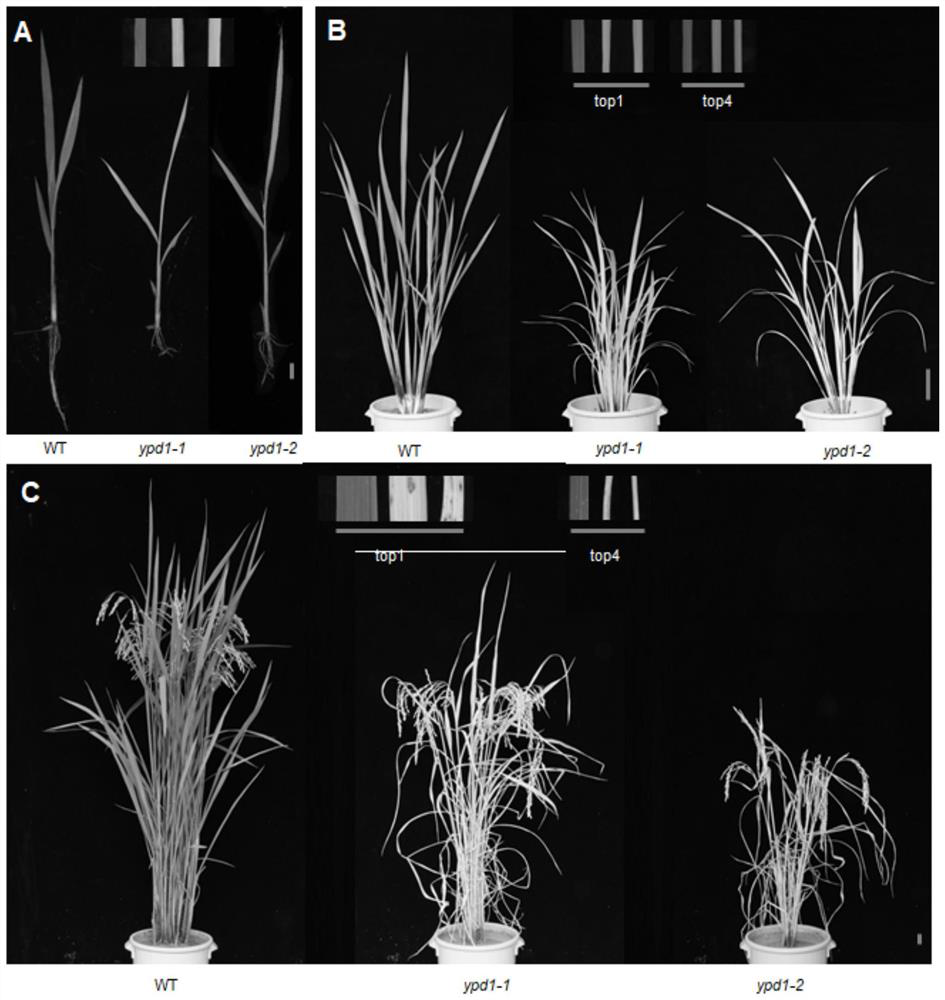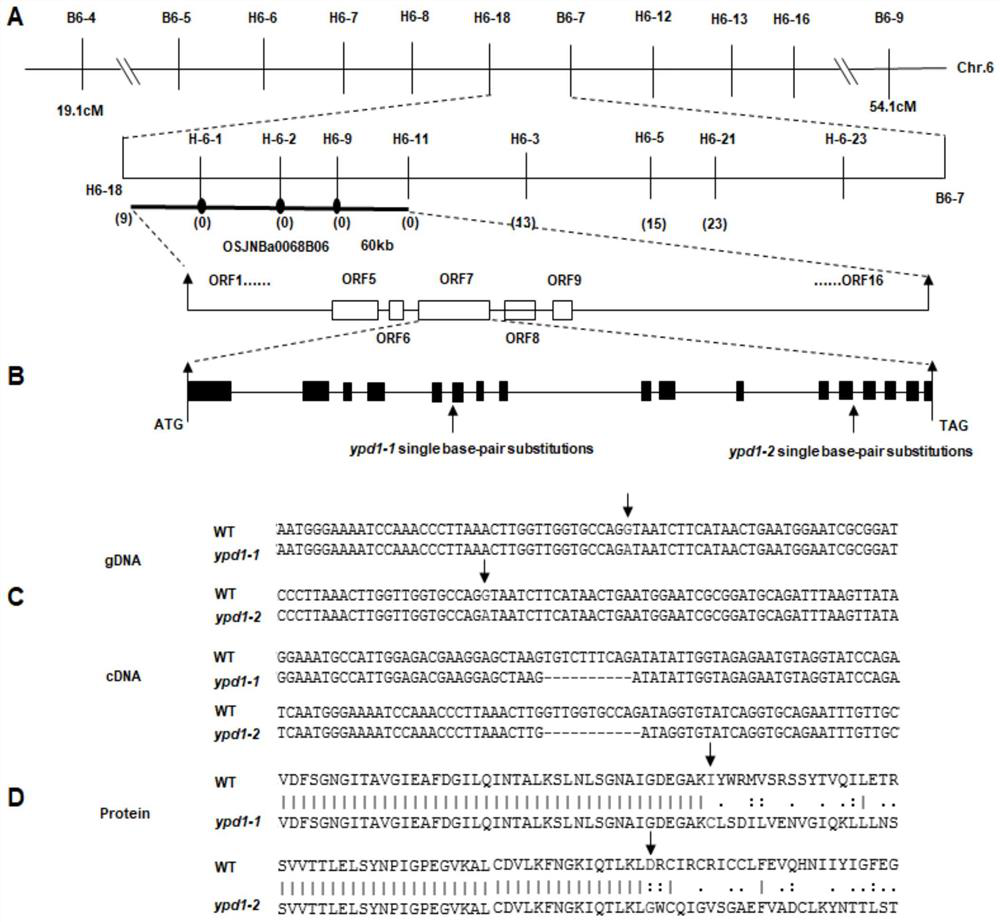Gene related to rice leaf color variation, premature senility and stress tolerance, protein coded by gene and application of protein
A technology of rice and genes, applied in the field of protein, achieves the effect of broad application prospects
- Summary
- Abstract
- Description
- Claims
- Application Information
AI Technical Summary
Problems solved by technology
Method used
Image
Examples
Embodiment 1
[0071] 1. Rice material:
[0072] Rice (Oryza sativa L.) mutants ypd1-1 and ypd1-2, the original wild material is the japonica rice variety "Nipponbare (NPB)".
[0073] Rice seedling yellow dwarf late stage senescence mutants ypd1-1 and ypd1-2 are from mutations produced by Nipponbare EMS mutagenesis (such as figure 1 shown), the mutant was obtained in Zhejiang Province, China. The agronomic traits compared with the control varieties are as follows:
[0074]
[0075] ** represents a very significant difference between the mutant and the wild type, P<0.01.
[0076] The mutagenesis method is specifically as follows: soak rice seeds with 1.5% EMS for 8 hours, rinse them with clean water and germinate normally; select the senescence mutants ypd1-1 and ypd1-2 in the seedling stage and the later stage of yellow dwarfing in the M1 generation, and use them after multiple generations of stable inheritance. for population construction and gene mapping.
[0077] In the ypd1-1 and ...
Embodiment 2
[0100] Plant Transformation:
[0101] Using the genome of the japonica rice variety "Nipponbare" as a template, primers were designed according to the target gene:
[0102] F1-5'-gctcggtacccggggatcc TTTGAGACCGAGTACAGAGAAGTATGT-3'
[0103] R1-5'-TAGCGACATAGCAGTCCAACTT-3';
[0104] F2-5'-TTGGAGCTGCTATGTCGCTAGG-3'
[0105] R2-5'-CTAGAGTAAATAGACAAAGTACATGTCAGTTAGT-3';
[0106] F3-5'-ACTTTGTCTATTTTACTCTAGTGGCAACTATG-3'
[0107] R3-5'-aggtcgactctagaggatccCAACCAATGACACTTAAAAAGTAAAAAAA-3'.
[0108] The PCR amplification system is: 50 μL PCR reaction system: template DNA 2 μL; 2×PCR buffer 25 μL; 2rnmoldNTP (Roche) 10 μL; KODFX (TOYOBO) enzyme 1 μL; 10 μM PrimerF 3 μL; 10 μM PrimerR 3 μL; ddH 2 O 6 μL; PCR amplification conditions: pre-denaturation at 94°C for 2 min; denaturation at 98°C for 10 s, annealing at 60°C for 30 s, extension at 68°C for 4 min; a total of 35 cycles; extension at 68°C for 10 min, and incubation at 15°C.
Embodiment 3
[0115] OsYPD1 genome structure and cDNA analysis:
[0116]According to the prediction in Rice Genome Annotation Project (RGAP) (https: / / rapdb.dna.affrc.go.jp / viewer / gbrowse / irgsp1 / ?name=chr01%3A1..50000), OsYPD1 (LOC_Os06g13050) It encodes a peroxidase family protein with 18 exons and 17 introns, the full length of gDNA is 9862bp, and the full length of cDNA is 2532bp. In order to further explore the function of the target gene, we designed two pairs of primers with different combinations (including the sequences available in the sequencing primers) for the amplification of the predicted full-length or partial fragments of cDNA. The newly designed primer sequences are: AnYPD1-GFP1F / R: cttctgcaggagctcggtaccATGGACACTCACCTCGTCGTCG; CTGCACAACATCGTCACCAGAC; AnYPD1-GFP2F / R: AGGACAGTCATATGGAGGGTGG; full-length, so we suspect that the predicted cDNA sequence in RGAP may not be the real coding sequence of OsYPD1. In order to verify this speculation, we used the predicted cDNA sequenc...
PUM
 Login to View More
Login to View More Abstract
Description
Claims
Application Information
 Login to View More
Login to View More - R&D
- Intellectual Property
- Life Sciences
- Materials
- Tech Scout
- Unparalleled Data Quality
- Higher Quality Content
- 60% Fewer Hallucinations
Browse by: Latest US Patents, China's latest patents, Technical Efficacy Thesaurus, Application Domain, Technology Topic, Popular Technical Reports.
© 2025 PatSnap. All rights reserved.Legal|Privacy policy|Modern Slavery Act Transparency Statement|Sitemap|About US| Contact US: help@patsnap.com



